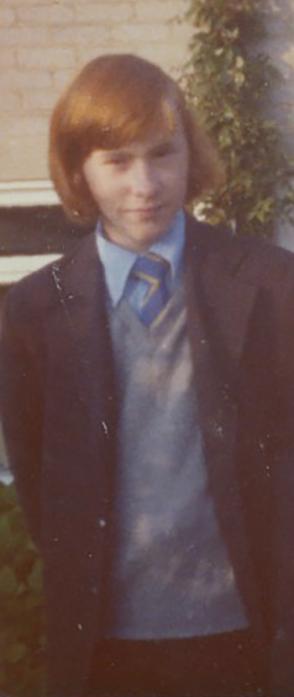
Local historian David Croom recalls his memories of school days in the 1970s while being unaware of the historic changes to the education system that were unfolding...
As children across Teesdale return to school for the start of the autumn term an unsettling thought came into my head, a sudden realisation that this September marks 50 years since I started as a pupil at Teesdale School.
Half a century has passed since I put on my new uniform for the first time and walked from my home in Baliol Street to the “big school” at the top of the town.
My parents, much like parents and grandparents today, insisted on a photograph of the big occasion, but unlike today no smart phones existed.
A camera was deployed to record the event, the film was then taken to Boots or Clarke’s chemist to be developed. A week later the prints were picked up and a disappointing array of photographs were eagerly examined. Some over developed, some under developed and some with heads missing but, if you were lucky, one or two decent ones.
After the event had been duly recorded I was free to set off for my first day.
In my smart blazer, tie and trousers that had been purchased from Swinbank’s Outfitters, in Horsemarket, during the summer with the school crest embroidered on the breast pocket, I felt quite grown up.
The blazer and trousers were a bit too big for me but I was assured by my mother that “I would grow into it,” and I was not alone in that – most of the new starters had mothers with the same idea. It distinguished us from the returning students whose trousers were often at “half mast” as their mothers tried to get a few more months out of last term’s uniform.
I remember the morning well. I had arranged to meet several of my friends from primary school so we could walk to school together.
There was a relay system in place so that the one who lived furthest from school set off first and then called on the next closest and the next and so on until by the time we reached school there were about eight of us.
During the summer holidays stories had reached us of what might befall the new arrivals at the hands of the older kids so by arriving together we were ready for any unpleasantness that might be coming our way.
In reality these were just stories put around to frighten the newbies. The older kids were far too busy meeting up again with their friends and telling of their antics over the summer to have any interest in the likes of us.
The first day, like every day, started with assembly. All the children gathered in the large hall facing the stage then the headmaster, deputy headmaster and headmistress walked on from the wings in full academic regalia of black gowns and with mortar boards on their heads. The rest of the teaching staff sat behind.
The children were welcomed back, notices were read out and the assembly ended with a hymn and a prayer. The school day had begun.
It was then off to our allocated form rooms where we met our form teacher.
The classes of about 30 students had been loosely arranged on academic ability with children from primary schools all across Teesdale.
My class had students from as far afield as High Coniscliffe, Cockfield, Ramshaw, Middleton and Forest-in-Teesdale.
Looking back now I was quite lucky to have come from a relatively large primary school in Barnard Castle.
I found the school to be large, imposing and frightening at times but imagine how that feeling must have been multiplied if you had previously been a student at a village primary school where there was only a handful of pupils.
The 1970s was a decade of significant change in the development of the education system in Teesdale.
In 1974 there were three state run secondary schools in Teesdale.
Teesdale School (previously Barnard Castle Grammar School); Baliol School (previously Barnard Castle Secondary Modern School); and Staindrop School (previously Staindrop Secondary Modern School)
Barnard Castle Secondary Modern School and Barnard Castle Grammar School had both been formally opened in 1959 to replace the old secondary school situated on the lower Demesnes which had been in use since 1837 and was no longer suitable for modern educational purposes.
The name changes had taken place in 1967 when school governors had decided that they didn’t want the words “Grammar” or “Modern” in the titles.
1959 also saw the opening of Middleton-in-Teesdale County Secondary Modern School with 110 pupils, however, its closure was announced in 1971 after an appeal to keep it open failed.
The school had been built at a cost of around £85,000 (approximately £2.5m today) and lasted only 12 years. It was announced that its pupils would be transferred to Teesdale School.
Teesdale School had been rapidly expanding since the early 1970s to accommodate the extra pupils it was now going to take from the upper dale.
It was first built to accommodate 300 pupils but a decade later it was planned to enlarge it to take 600 students with plans to more than double the capacity again to 1,380 in the future.
In 1971 plans were submitted for the building of a new dining block and kitchen, a new science block, nine new teaching rooms on the ground floor and three on the first floor, it was proposed to change the present kitchen to sixth form study rooms and the current dining hall to be turned into a library.
By the time I started in September 1974 these new buildings had been erected and had been in use for about a year.
However, the official opening ceremony of the new science block didn’t take place until October 1974 when the Teesdale Mercury reported that some parents and students objected to the cost of an official opening ceremony at a time when education budgets were being cut. Two local councillors who were to due to open the block withdrew in protest and had to be replaced by two other councillors.
The school continued to grow over the next few years with a new humanities block being erected during my first year.
Although the title “Grammar School” was no longer being used in 1974, the ethos of a grammar school still existed and pupils were still graded on academic ability.
The 11+ exam was no longer used but students were graded during their final year at primary school, with the top 50 per cent of students going to Teesdale School and the rest going to Baliol School.
Parents and pupils had an anxious wait over the summer until the letter finally arrived stating which school the child would be attending in September and then there was a rush to order the relevant uniform in time for the start of term.
I remember my parents being proud that I had been accepted to what was still considered to be the grammar school (although I think it was by the skin of my teeth!) but for me it was bitter sweet as some of my friends went to Baliol School.
What we weren’t aware of at the time was that a new educational system was already in the pipeline which didn’t require pupils to be graded on academic ability at the age of 11 and this was the emergence of the “comprehensive school.”
In July 1974 the Teesdale Mercury reported that there were three options on the table to effectively change from the two tier system of education to the comprehensive system.
The first was to merge Teesdale and Baliol schools under a single head teacher which would involve students having to move between sites. Staindrop School would accommodate students up to the age of 16 and those staying on after that would be transferred to the Teesdale/Baliol school site.
The second was to merge all three schools under one head teacher with pupils attending the one that was closest to where they lived.
The three schools would offer a different choice of courses and at age 13 pupils could choose which school they wanted to attend based on their choice of courses.
The third scheme was that all pupils attended either Baliol or Staindrop Schools at the age of 11 and at the age of 14 they all moved to Teesdale School.
None of the options was considered perfect and a lengthy consultation period followed. Some parents felt that the current system was better than any of the options on the table but it was stated that the county council were committed to the comprehensive system and that the ultimate goal was to invest £500,000 into the Teesdale School site and make it into a single site for comprehensive education.
In November of 1974 it was announced that £300,000 would be made available to upgrade Teesdale School so that all students from Barnard Castle and the upper dale would be taught on a single site. Pupils at Baliol School would be transferred to Teesdale and Baliol School would become a primary school. Staindrop School would be kept as a separate comprehensive taking students primarily from the Staindrop, Cockfield and Evenwood areas.
I was eventually reunited with my friends from Baliol School when the two schools finally merged in 1977.





